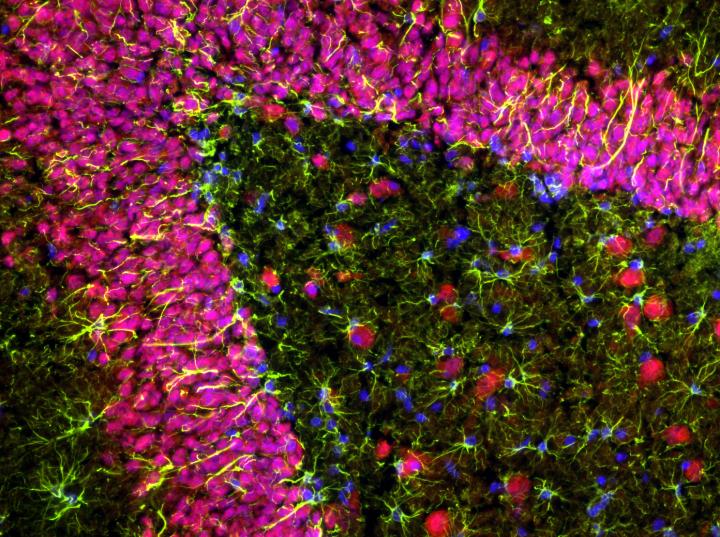Animal study targets Alzheimer’s disease before symptoms are apparent

Credit: Giorgia Menegoni, Sapienza, University of Rome
Bethesda, MD – In a new animal study examining Alzheimer’s disease, researchers found that disease progression could be slowed by decreasing neuroinflammation in the brain before memory problems and cognitive impairment were apparent. The new findings point to the importance of developing therapies that target very early stages of the disease.
In 2011, the National Institute on Aging updated the diagnostic criteria for Alzheimer’s disease to reflect its progressive nature. The criteria added a preclinical stage during which brain changes are taking place, but the person is still asymptomatic and, therefore, unaware of his condition. Biomarker profiles could eventually be used to identify people in the disease’s early stages who might benefit from early treatments.
“Starting an intervention at the earliest stage of the disease, when cellular and molecular alterations have already been triggered but major damage to the brain has not yet occurred, could offer a way to reduce the number of people who go on to develop full Alzheimer’s dementia,” said research team leader Caterina Scuderi, PhD, assistant professor of pharmacology and toxicology from Sapienza, University of Rome. “However, there have been few studies in animals examining therapeutic strategies that target timepoints before symptoms can be seen.”
Scuderi was scheduled to present this research at the American Association for Anatomy annual meeting in San Diego this month. Though the meeting, to be held in conjunction with the 2020 Experimental Biology conference, was canceled in response to the COVID-19 outbreak, the research team’s abstract was published in this month’s issue of The FASEB Journal.
The researchers designed an animal study to gain a deeper understanding of neuroinflammation’s role in Alzheimer’s disease during the pre-symptomatic stage of the disease, which might represent the best time for therapeutic intervention. The study results suggest that rebalancing neuroinflammation in animals that show altered neuroinflammatory parameters could be beneficial.
“Our results help demonstrate that neuroinflammation in Alzheimer’s disease is an extremely complex phenomenon that can change over the disease’s progression and varies based on factors such as affected brain area,” said Scuderi. “We hope that these findings will prompt scientists to further investigate neuroinflammation at the earliest stages of the disease, which may represent an important pharmacological target.”
###
Contact the media team for more information.
Image available.
About Experimental Biology 2020
Experimental Biology is an annual meeting that attracts more than 12,000 scientists and exhibitors from five host societies and more than two dozen guest societies. With a mission to share the newest scientific concepts and research findings shaping clinical advances, the meeting offers an unparalleled opportunity for exchange among scientists from across the U.S. and the world who represent dozens of scientific areas, from laboratory to translational to clinical research. http://www.
About the American Association for Anatomy (AAA)
The American Association for Anatomy is an international membership organization of biomedical researchers and educators specializing in the structural foundation of health and disease. AAA connects gross anatomists, neuroscientists, developmental biologists, physical anthropologists, cell biologists, physical therapists, and others to advance the anatomical sciences through research, education, and professional development. To join, visit anatomy.org.
About The FASEB Journal
Receive monthly highlights from The FASEB Journal by e-mail. Sign up at http://www.
Find more press materials at: https:/
Media Contact
Anne Frances Johnson
[email protected]




